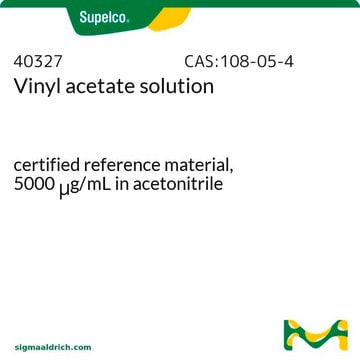48486
Vinyl acetate
analytical standard
Synonim(y):
Acetoxyethylene
About This Item
Polecane produkty
klasa czystości
analytical standard
agency
EPA 8240,8260
gęstość pary
3 (vs air)
ciśnienie pary
88 mmHg ( 20 °C)
Certyfikat analizy
current certificate can be downloaded
temp. samozapłonu
801 °F
granice wybuchowości
13.4 %
opakowanie
pkg of 1000 mg
metody
HPLC: suitable
gas chromatography (GC): suitable
współczynnik refrakcji
n20/D 1.395 (lit.)
tw
72-73 °C (lit.)
mp
−93 °C (lit.)
gęstość
0.934 g/mL at 25 °C (lit.)
Zastosowanie
cleaning products
cosmetics
environmental
food and beverages
personal care
petroleum
format
neat
temp. przechowywania
2-8°C
ciąg SMILES
CC(=O)OC=C
InChI
1S/C4H6O2/c1-3-6-4(2)5/h3H,1H2,2H3
Klucz InChI
XTXRWKRVRITETP-UHFFFAOYSA-N
Szukasz podobnych produktów? Odwiedź Przewodnik dotyczący porównywania produktów
Opis ogólny
Zastosowanie
Inne uwagi
Hasło ostrzegawcze
Danger
Zwroty wskazujące rodzaj zagrożenia
Zwroty wskazujące środki ostrożności
Klasyfikacja zagrożeń
Acute Tox. 4 Inhalation - Aquatic Chronic 3 - Carc. 2 - Flam. Liq. 2 - STOT SE 3
Organy docelowe
Respiratory system
Kod klasy składowania
3 - Flammable liquids
Klasa zagrożenia wodnego (WGK)
WGK 2
Temperatura zapłonu (°F)
17.6 °F - closed cup
Temperatura zapłonu (°C)
-8 °C - closed cup
Środki ochrony indywidualnej
Eyeshields, Faceshields, Gloves, type ABEK (EN14387) respirator filter
Choose from one of the most recent versions:
Masz już ten produkt?
Dokumenty związane z niedawno zakupionymi produktami zostały zamieszczone w Bibliotece dokumentów.
Klienci oglądali również te produkty
Nasz zespół naukowców ma doświadczenie we wszystkich obszarach badań, w tym w naukach przyrodniczych, materiałoznawstwie, syntezie chemicznej, chromatografii, analityce i wielu innych dziedzinach.
Skontaktuj się z zespołem ds. pomocy technicznej
















